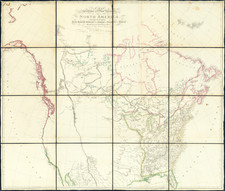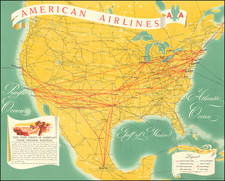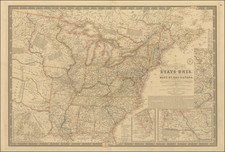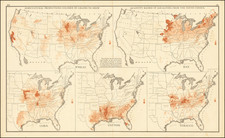The Only Map Taken By Lewis & Clark on the Expedition to the Source of the Missouri River
Full color example of Aaron Arrowsmith's map of North America, one of the seminal maps for the early history of the Transmississippi West and the primary map utilized by Lewis & Clark.
The present example of Arrowsmith's map is the first 1802 edition (5th State overall). Arrowsmith's map was the only map brought on the expedition and was consulted by Lewis & Clark at various points in the first leg of their journey in search of the headwaters of the Missouri. Three journal entries of Merriwether Lewis in early June 1805 specifically reference the expeditions attempts to reconcile the contents of the Arrowsmith map with the information provided by the local Indians, in order to determine which of the branches of the Missouri might provide the best possible portage through the Rocky Mountains.
The 1802 Edition of Arrowsmith's Map
Arrowsmith's 1802 map incorporated several monumental changes not present in the four 1795 editions of the map. For Lewis & Clark, the most notable are those added to the Upper Missouri River regions. The 1802 Arrowsmith was the first to show the Upper Missouri joined with the Mississippi River in its correct location. The ruins of Fort Orleans, built by the French fur trapper and explorer Bourgmont in the early 1700s is shown on the Lower Missouri. The course of the Missouri River, below the Kansas River to the Mississippi, is significantly improved, although above the Kansas River and the Mandan Villages, the Arrowsmith map references "the most Northern Bend of the Missesouri Rios" (an area derived from David Thompson's manuscript map of 1798), but still lacks the information recently obtained by the Spanish / St. Louis fur traders in the preceding decade.
Above and west of the Mandan Villages, the map incorporates for the first time the reports of Peter Fidler for the Hudson's Bay Company, by including a series of possible river courses to the west, leading to (and prospectively through) the Rocky Mountains. It was this section of the map that provided the best depiction of the prospect of a water route or portage through the Rocky Mountains and to the Pacific. It was this information, along with reports from local Indians encountered on the expedition, which Lewis & Clark relied in choosing their path to the Rocky Mountains.
On the far side of the Rocky Mountains, a section of river called the Great Lake River includes a speculative water course which flowed to the River Oregan (Columbia River), included a note stating that "the Indians say they sleep 8 Nights in descending this River to the Sea." This note was one more factor which led to the exploration of this route as a means of a locating navigable route by water to the Pacific Ocean.
The additions and corrections present in the fifth and sixth states of the map, coming from Peter Fidler and the Hudson Bay Company, were the result of Fidler's extensive contacts with the indigenous tribes on the eastern slope of the Rocky Mountains and contributed greatly to the geographical knowledge of the region prior to the return of Lewis & Clark in 1806. The information was transmitted through the Hudson's Bay Company channels back to England and very quickly delivered to Arrowsmith, who was then the primary mapmaker for the HBC.
With this fifth state, the evolving map now extends south to 29° and in the west to Cook's Inlet. Cook's tracks are shown. The projection is no longer a simple conic; south of 40° the meridians begin to curve in. The map renders a depiction of the Rocky Mountains and the sources of the Missouri River, which must have originated with Indian sources, including those taken from Peter Fidler's reports to the Hudson Bay Company and other sources not identified.
The large blank areas in the west show how little was known about the lands up the Missouri River Valley and across the Rocky Mountains and reflect the blank canvas upon which the mapping of the west would be drawn over the next 4 decades. Explorers had probed the edges of the region, but Europeans had not yet penetrated the interior.
For a complete discussion of the map, see Warren Heckrotte, "Aaron Arrowsmith's Map of North America and the Lewis and Clark Expedition" in The Map Collector No. 39, Summer 1987.
Lewis & Clark
Both the 1795 and 1802 editions of Arrowsmith's map were used by Nicholas King in his preparation of the primary manuscript map used on the Lewis and Clark Expedition. However, only the 1802 Arrowsmith map (state 5) was carried on the expedition by Lewis & Clark.
As noted by Warren Heckrotte:
On the third of June, 1804, the Lewis and Clark expeditionary party ascending the Missouri River came unexpectedly to "the junction of two large rivers." The information the two captains had obtained from the Minnatree Indians at the expedition's winter camp, Fort Mandan, near the Great Bend of the Missouri had not indicated the presence of a branch of the river at this location. The decision as to which branch was the Missouri was a critical one: the wrong choice "might defeat the expedition altogether." For the next week the captains reconnoitered the two branches. By June 10 they had decided the south branch was the Missouri. Lewis set out ahead of Clark to search for the critical text -- the Great Falls of the Missouri. On June 13 he found them . . .
DeVoto calls the reasoning of the two captains at this juncture a remarkably act of the mind that should occupy a distinguished place in the history of thought.
In their considerations the captains brought to bear the great map of North America by Aaron Arrowsmith. . . .
In making this critical decision, Arrowsmith's map was the focal point. As noted by Heckrotte:
On June 8 the journal of the expedition summarized their assessment of the relevant portions of Arrowsmith's map. Lewis believes from the map that [Peter] Fidler had descended along the eastern side of the Rocky Mountains to the "remarkable mountain" called the "Tooth" at latitude 46º north and that Fidler had not seen the Missouri on the journey, "only small streams coming down from the mountains." The captains reasoned that Fidler could not have come so far south without meeting the great river and concluded that Fidler and the map were in major error in this region.
In concluding the Lewis & Clark utilized this fifth state, rather than the sixth, Heckrotte addresses the difference between the two states. The most salient point raised by Heckrotte is that in the sixth state (issued in late 1802 or early 1803), a number of new river names are added flowing eastward from the Rocky Mountains, including "the river which flows from the Bears Tooth [ ] named "Mississury." Heckrotte notes that Journal entries referenced above would not have made sense if Lewis & Clark had brought the sixth state, which specifically names the "Mississury."
Thomas Jefferson
Thomas Jefferson also owned the 1802 map, as well as an 1802 edition of Arrowsmith's map of the United States. Arrowsmith's 1802 map of North America was the most comprehensive map of the West available to Jefferson and Lewis and it was probably the most important map used in the planning of the expedition and the map which inspired Jefferson's visualization of what would become known as American manifest destiny.
The information on the map also fed Jefferson's misconceptions of western geography, most notably is depiction of the Rocky Mountains as a single long chain, along with depiction of source of the Missouri River at the eastern edge of the Rockies, suggesting the prospect of an easy portage across through the mountains.
Editions of the Map
Arrowsmith's map was published in a number of editions between 1795 and 1824, with the later editions by his son John Arrowsmith in 1833 and 1839.
The present state (5th state) is one of three states dated 1802 and is one of the rarest. The three 1802 states can be differentiated as follows:
- 5th State: First state to name the Rocky Mountains. Map expanded from 4 sheets to 6 sheets, with greater coverage to the south. The 5th state is the first to incorporate Peter Fidler's rivers extending from the Mandan Villages to the Rocky Mountains, based upon the reports of Peter Fidler. Because these rivers were based upon Indian accounts and not actual observations, they are shown as dashed lines. South of Cattanahowes tribe of Indians there are 4 place names on the East side of the Rocky Mountains and the rivers directly below the name Cattanahowes are not connected to the Askow or Bad River. The southernmost name on the Fidler Rivers is Bear's Tooth. Likely issued in early 1802.
- 6th State: The Askow or Bad River system now flows around both sides of the Cattanahowes and has been significantly revised. There are more place names on the Fidler Rivers along the eastern side of the Rocky Mountains, including approximately 7 new names south of Bear's Tooth. Likely issued in the Winter of 1802-1803, as the revisions are drawn from reports forwarded by the Hudson's Bay Company which are believed to have reached Arrowsmith sometime between late October and early December of 1802.
- 7th State: Dated 1802, but includes Arrowsmith's Soho Square address and thus is 1808 or later, but before the 8th State, which includes "Additions to 1811."
The map is generally considered as the single most important series of maps of North America during the first 50 years after the American Revolution.
Rarity
Because the map was only published for about one year, it is one of the rarest states of the map. The present example was acquired in 2016 in Italy. The last example to appear on the market was the Heckrotte Copy, purchased by the Library of Congress in 2015 for approximately $85,000. Prior to these examples, we trace no other examples at auction or in dealer catalogs. For example, map was not in the collections of Wheat or Streeter.
The Arrowsmiths were a cartographic dynasty which operated from the late-eighteenth century to the mid-nineteenth. The family business was founded by Aaron Arrowsmith (1750-1823), who was renowned for carefully prepared and meticulously updated maps, globes, and charts. He created many maps that covered multiple sheets and which were massive in total size. His spare yet exacting style was recognized around the world and mapmakers from other countries, especially the young country of the United States, sought his maps and charts as exemplars for their own work.
Aaron Arrowsmith was born in County Durham in 1750. He came to London for work around 1770, where he found employment as a surveyor for the city’s mapmakers. By 1790, he had set up his own shop which specialized in general charts. Arrowsmith had five premises in his career, most of which were located on or near Soho Square, a neighborhood the led him to rub shoulders with the likes of Joseph Banks, the naturalist, and Matthew Flinders, the hydrographer.
Through his business ties and employment at the Hydrographic Office, Arrowsmith made other important relationships with Alexander Dalrymple, the Hudson’s Bay Company, and others entities. In 1810 he became Hydrographer to the Prince of Wales and, in 1820, Hydrographer to the King.
Aaron Arrowsmith died in 1823, whereby the business and title of Hydrographer to the King passed to his sons, Aaron and Samuel, and, later, his nephew, John. Aaron Jr. (1802-1854) was a founder member of the Royal Geographical Society (RGS) and left the family business in 1832; instead, he enrolled at Oxford to study to become a minister. Samuel (1805-1839) joined Aaron as a partner in the business and they traded together until Aaron left for the ministry. Samuel died at age 34 in 1839; his brother presided over his funeral. The remaining stock and copper plates were bought at auction by John Arrowsmith, their cousin.
John (1790-1873) operated his own independent business after his uncle, Aaron Arrowsmith Sr., died. After 1839, John moved into the Soho premises of his uncle and cousins. John enjoyed considerable recognition in the geography and exploration community. Like Aaron Jr., John was a founder member of the RGS and would serve as its unofficial cartographer for 43 years. Several geographical features in Australia and Canada are named after him. He carried the title Hydrographer to Queen Victoria. He died in 1873 and the majority of his stock was eventually bought by Edward Stanford, who co-founded Stanford’s map shop, which is still open in Covent Garden, London today.











![[ Military Departments ] Johnson's New Military Map of the United States Forts, Military Posts & all the Military Divisions with Enlarged Plans of the Southern Harbors . . .](https://storage.googleapis.com/raremaps/img/small/101114.jpg)
![[United States]](https://storage.googleapis.com/raremaps/img/small/93852.jpg)

![[Pocket Atlas of Denison's Annual and Seasonal Climatic Maps of the United States] Descriptive Circular of The Annual and Seasonal Climatic Maps of the United States . . . .](https://storage.googleapis.com/raremaps/img/small/88162.jpg)
